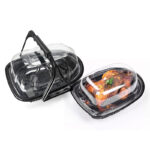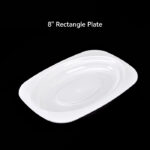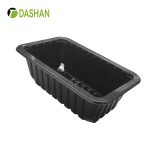The article profiles Subway’s adoption of sugarcane pulp (bagasse) tableware across select markets, detailing formats like clamshells, bowls, trays, and serviceware. It explains why bagasse fits high-volume QSR needs (heat/grease resistance, rigidity, compostability), outlines operational wins and challenges (cost, coatings, end-of-life), and shares expert insight and field feedback. The piece closes with a rollout playbook and roadmap for smarter, greener packaging at scale.
1. Introduction
As the global push for sustainability intensifies, businesses across the foodservice industry are increasingly turning to eco-friendly solutions. Subway, one of the largest fast-food chains globally, has committed to reducing its environmental footprint through innovative sustainable practices. One of the most notable initiatives Subway has embraced is the use of sugarcane pulp (bagasse) in their packaging and tableware. This shift to biodegradable and compostable materials is not only in line with the company’s sustainability goals but also responds to growing consumer demand for more environmentally responsible products.
In this article, we explore how Subway has incorporated sugarcane pulp in their food packaging and dining solutions. We will also analyze the benefits of sugarcane pulp as an eco-friendly material, the global trends driving its use, and how Subway’s adoption of this material aligns with broader industry shifts toward sustainability.
2. What is Sugarcane Pulp (Bagasse)?
Before delving into Subway’s adoption of sugarcane pulp, it’s important to understand what sugarcane pulp, also known as bagasse, is and why it’s become a popular alternative to traditional plastic.
Sugarcane pulp is a byproduct of sugarcane processing, which involves extracting sugar from the stalks of the sugarcane plant. After the juice is removed, the fibrous pulp remains. Traditionally discarded as waste, this material is now being repurposed to create a variety of biodegradable products, including food containers, tableware, and packaging materials.
The primary advantages of sugarcane pulp include:
-
Biodegradability: Unlike plastic, sugarcane pulp breaks down naturally over time, causing minimal harm to the environment.
-
Renewable Resource: Sugarcane is a renewable resource, making its use much more sustainable compared to petroleum-based plastics.
-
Compostability: Sugarcane pulp can be composted, enriching soil and further reducing waste.
For companies like Subway, these characteristics make sugarcane pulp an attractive choice for packaging and tableware, especially as part of their larger efforts to minimize single-use plastic products.
About Subway
Founded in 1965, Subway has grown from a single sandwich shop into one of the world’s largest quick-service restaurant brands, operating tens of thousands of locations across 100+ countries. Its core proposition—made-to-order sandwiches and salads with a strong emphasis on freshness, customization, and speed—has made Subway a staple for commuters, students, and office workers alike. The company’s franchise-driven model and standardized operations enable rapid menu rollouts and operational changes at scale, which is especially relevant when implementing global sustainability initiatives.
In recent years, Subway has broadened its brand promise beyond convenience and freshness to include responsible sourcing, packaging innovation, and waste reduction. This shift reflects rising customer expectations and tightening regulations on single-use plastics across key markets in North America, Europe, and Asia. By piloting and scaling alternative packaging—such as sugarcane pulp (bagasse) tableware and containers—Subway is leveraging its global footprint to lower environmental impact while maintaining the functionality and food safety standards required in high-volume foodservice.
3. How Subway Has Adopted Sugarcane Pulp Tableware
Food Packaging Boxes and Containers
One of the most significant areas where Subway has implemented sugarcane pulp is in their food packaging. Historically, fast-food chains have relied heavily on plastic and foam containers, which take hundreds of years to decompose in landfills. However, as part of their sustainability commitment, Subway has begun using sugarcane pulp for their sandwich packaging boxes and food containers in select markets.
In Europe, North America, and parts of Asia, Subway now offers biodegradable sandwich containers made from sugarcane pulp. These containers are not only eco-friendly but also serve as a great alternative to plastic or Styrofoam packaging, both of which contribute to environmental pollution.
Sugarcane pulp boxes have the following benefits:
-
Strength and Durability: Sugarcane pulp is a highly durable material, making it ideal for carrying foods such as sandwiches, wraps, and salads.
-
Heat Resistance: It can withstand high temperatures, which is important for packaging hot food.
-
Grease Resistance: Sugarcane pulp packaging is resistant to grease and oil, which is essential for holding food like sandwiches or fried items.
Plates, Bowls, and Cutlery
Subway has also introduced sugarcane pulp tableware in some locations. Plates, bowls, and cutlery made from bagasse are now being used in select markets, offering customers an entirely biodegradable dining experience. These sugarcane pulp products are a perfect alternative to plastic or foam plates commonly used in fast-casual restaurants.
-
Compostable: After use, these plates and cutlery can be composted, contributing to waste reduction.
-
Eco-friendly: By adopting these sugarcane pulp products, Subway is helping reduce the environmental impact of single-use plastics.
-
Functional: Sugarcane pulp tableware is designed to be functional and sturdy, making it suitable for both hot and cold foods.
Packaging Paper and Bags
Subway’s commitment to reducing its plastic footprint extends beyond tableware to their packaging materials. In select locations, Subway uses sugarcane pulp in their packaging paper and takeaway bags. These bags are biodegradable, providing an environmentally friendly alternative to plastic bags.
These materials are typically used in the following ways:
-
Takeaway Packaging: Customers who opt for takeaway are provided with eco-friendly bags made from sugarcane pulp, helping reduce the reliance on plastic bags.
-
Sandwich Wrapping Paper: Instead of using plastic wraps or wax paper, Subway is shifting to biodegradable wrapping options made from sugarcane pulp, ensuring that the packaging is sustainable throughout the customer’s meal.
4. Why Subway Chose Sugarcane Pulp
Subway’s decision to adopt sugarcane pulp tableware and packaging is based on several strategic factors:
Environmental Impact
Subway’s primary goal with the adoption of sugarcane pulp is to reduce its environmental footprint. By using biodegradable and compostable materials, Subway significantly cuts down on plastic waste. This aligns with the company’s sustainability efforts to reduce its carbon footprint and contribute to the global effort to fight plastic pollution.
Consumer Demand for Sustainability
As consumers become more environmentally conscious, they are demanding more sustainable options. Subway’s choice to offer eco-friendly packaging and biodegradable tableware demonstrates the company’s response to these shifting consumer preferences. By adopting sustainable solutions like sugarcane pulp, Subway is meeting consumer expectations while enhancing its corporate social responsibility profile.
Regulatory Compliance
Regulations around packaging and sustainability are tightening globally. In Europe and North America, governments are introducing stricter rules on single-use plastics. By adopting sugarcane pulp products, Subway is proactively complying with these regulations, ensuring their operations remain future-proof in markets where sustainability is becoming a priority.
5. Global Impact and Challenges
Global Adoption and Market Reach
Subway’s use of sugarcane pulp tableware and packaging is part of a larger global trend towards more sustainable dining and packaging practices. As the company operates thousands of locations across the world, their adoption of eco-friendly materials has a significant global impact, especially in regions where waste management and plastic reduction are key priorities. This approach not only contributes to Subway’s sustainability goals but also encourages other foodservice businesses to follow suit.
Challenges
While the adoption of sugarcane pulp materials is a positive step toward sustainability, there are challenges to widespread implementation. These include:
-
Cost: Sugarcane pulp products can be more expensive than traditional plastic, which could increase operational costs for Subway in the short term.
-
Supply Chain Issues: Ensuring a consistent and reliable supply of sugarcane pulp materials across all Subway locations is crucial for maintaining the brand’s sustainability commitment.
-
Consumer Education: Educating customers on the benefits of compostable and biodegradable packaging is essential for maximizing the environmental impact.
6. The Future of Sugarcane Pulp in Fast Food
As sustainability continues to shape the future of packaging in the foodservice industry, sugarcane pulp will play an increasingly important role. Subway’s use of this material is just the beginning. In the coming years, we can expect more innovative solutions to emerge, including the integration of sugarcane pulp with other renewable materials, such as algae or bamboo. This evolution will lead to even more sustainable packaging options that can be scaled up to meet the demands of both customers and regulatory standards.
Subway is committed to further reducing its plastic usage and continuing to innovate with eco-friendly alternatives. Through these efforts, Subway hopes to lead the way in green packaging solutions, ensuring that their brand remains a top choice for environmentally conscious consumers.
7. Conclusion
Subway’s use of sugarcane pulp tableware is a significant step toward achieving sustainability in the fast-food industry. By adopting biodegradable and compostable materials, Subway is not only reducing its environmental footprint but also providing consumers with a sustainable choice. The company’s commitment to using sugarcane pulp reflects a larger trend within the foodservice industry towards greener, more sustainable practices. As environmental concerns grow and consumer demand for sustainability increases, more companies will follow Subway’s lead and adopt sugarcane pulp and other eco-friendly alternatives in their packaging and tableware solutions.
FAQ
-
What is sugarcane pulp?
Sugarcane pulp (or bagasse) is the fibrous residue left after extracting juice from sugarcane. It is a renewable, biodegradable material used to create eco-friendly packaging and tableware. -
Why did Subway switch to sugarcane pulp tableware?
Subway switched to sugarcane pulp to reduce plastic waste, comply with environmental regulations, and meet consumer demand for sustainable products. -
Are sugarcane pulp products compostable?
Yes, sugarcane pulp products are compostable, breaking down naturally in the environment and reducing waste. -
Where can I find Subway’s sugarcane pulp tableware?
Subway uses sugarcane pulp tableware and packaging in select markets worldwide, including parts of North America, Europe, and Asia. -
What are the benefits of using sugarcane pulp in packaging?
Sugarcane pulp is biodegradable, compostable, renewable, and provides a durable, eco-friendly alternative to plastic.
References
-
ASTM D6400 — Compostable Plastics Standard(ASTM)
https://www.astm.org/d6400-21.html -
EN 13432 — Compostable Packaging Requirements(EN Standards)
https://www.en-standard.eu/bs-en-13432-2000-packaging.-requirements-for-packaging-recoverable-through-composting-and-biodegradation.-test-scheme-and-evaluation-criteria-for-the-final-acceptance-of-packaging/ -
BPI — Certified Compostable Products(Biodegradable Products Institute)
https://bpiworld.org/ -
U.S. EPA — Composting Basics(Home & Commercial Composting)
https://www.epa.gov/recycle/composting-home -
U.S. EPA — Composting Overview(Sustainable Management of Food)
https://www.epa.gov/sustainable-management-food/composting -
European Commission — Single-Use Plastics Rules & Restrictions
https://environment.ec.europa.eu/topics/plastics/single-use-plastics_en -
European Commission — Restrictions on Certain Single-Use Plastics (from 3 July 2021)
https://environment.ec.europa.eu/topics/plastics/single-use-plastics/eu-restrictions-certain-single-use-plastics_en -
Government of Canada — Single-Use Plastics Prohibition Regulations (Overview)
https://www.canada.ca/en/environment-climate-change/services/managing-reducing-waste/reduce-plastic-waste/single-use-plastic-overview.html -
Government of Canada — Labelling Rules for Plastic Packaging & Single-Use Plastics
https://www.canada.ca/en/environment-climate-change/services/managing-reducing-waste/reduce-plastic-waste/labelling-rules-plastic-packaging-and-single-use-plastics.html -
Britannica — Bagasse (Sugarcane Pulp) Definition & Uses
https://www.britannica.com/technology/bagasse -
OEHHA (California) — Proposition 65 Chemicals List
https://oehha.ca.gov/proposition-65/proposition-65-list -
Ellen MacArthur Foundation
https://www.wired.com/story/ellen-macarthur-foundation-plastics-prize-circular-economy




